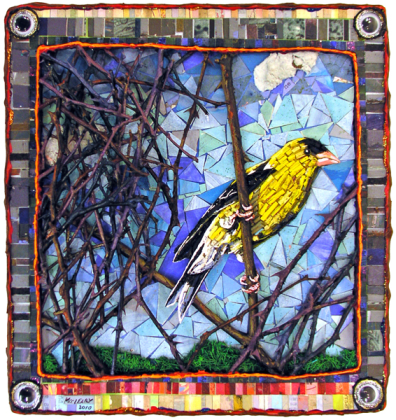McCleary, Mary - VM - Ned Bustard
Mary McCleary: Goldfinch in Thorns

Not Ashamed
by Ned Bustard
For I am not ashamed of the gospel, for it is the power of God for salvation to everyone who believes, to the Jew first and also to the Greek, Romans 1:16 (ESV)
In Goldfinch in Thorns—a 2010 collage by 2011 ‘Texas Artist of the Year’ Mary McCleary—a goldfinch is perched in the branches of a thorn bush. Because of the thistle seeds it eats, the goldfinch is associated in Christian symbolism with the Passion and the crown of thorns worn by Christ. For example, in Madonna of the Goldfinch by Raphael (c. 1505-1506) the crucifixion is foreshadowed as Jesus pets the head of a goldfinch that is being held by his cousin, John. (see Raphael’s painting here)
The bright little bird in McCleary’s piece is a construction of paint and bits of this and that, part of the picture, but also coming out of the piece to grasp real thorn branches. All of McCleary’s works have this interplay between two and three dimensions. She assembles her collages from all manner of unusual materials. Here she has used everything from paint and paper to thorn branches and miniature artificial vegetation.
When compared to the rest of McCleary’s body of work, this piece is rather small (11 x 11 inches). It is also the last time Mary used the googly eyes in her work, though they appeared consistently in her works for many years. In the book Objects of Grace: Conversations on Creativity and Faith, Mary explained why she used them in her art: ‘I needed a metaphor for God’s omniscience and omnipresence within the biblical narratives I was exploring. The eyes were a reminder that he is in charge, superintending over events. In addition, the two-dimensional grid created an interesting contrast to the three-dimensional objects and materials from which the works are made, as well as the three-dimensional illusion of the subject. They anchor the image in place and hold the work together.’
McCleary saw the work of God superintending over events in her life in her mid-thirties, when she became a follower of Christ. Already a successful artist in the Texas art community, when she became a Christian her work turned to biblical narratives. Her overt imagery did not hurt her sales and to this day her art continues to sell well.
When I look at this delightful piece of art, I can’t help but see the bright goldfinch as a symbol not just for the Passion, but also for Mary McCleary herself. She is perched in the often prickly art world, a bold testament to God’s beautiful work of redemption. She is safe under the loving gaze of her omniscient and omnipresent Father, pointing everyone to the glory to be found in the broken Creation.
*******
Mary McCleary: Goldfinch in Thorns, 2010, 11 x 11 inches, collage on paper.
Mary McCleary is Regent's Professor of Art Emeritus at Stephen F. Austin State University, where she taught from 1975 to 2005. Born in Houston, Texas in 1951, she received her BFA, cum laude in printmaking/drawing at Texas Christian University and her MFA in graphics from the University of Oklahoma. Since 1970 she has participated in over 250 one person and group exhibits in museums and galleries in 24 states, Mexico, and Russia. Mary McCleary was named ‘Texas Artist of the Year’ for 2011 by the Art League of Houston. McCleary’s work is in many public collections. See www.marymccleary.com.
Artist Statement: ‘I made my first 3-D collage 26 years ago. Since that time my work has grown in size, complexity and meaning. The collages are made by attaching layer upon layer of materials such as paint, paper, rag board, foil, glitter, sticks, wire, mirrors, pencils, nails, glass, painted toothpicks, string, leather, lint, small plastic toys and other objects on heavy paper, much in the way a painter builds layer upon layer of paint on canvas. Often these materials are used symbolically. My aim is that the obsessive images that result from this method of working convey an intensity which the viewer finds compelling. I am interested in the spatial complexity and visual tensions that come from the collages being illusionistic, while at the same time composed of three-dimensional objects that often retain their own identity. Drawing my subject matter from history and literature, I like the irony of using materials that are often trivial, foolish, and temporal to express ideas of what is significant, timeless, and transcendent.’
Ned Bustard is a graphic designer, author, illustrator, printmaker, and the creative director for Square Halo Books.
ArtWay Visual Meditation June 9, 2013






